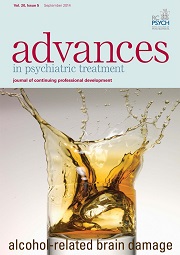Crossref Citations
This article has been cited by the following publications. This list is generated based on data provided by
Crossref.
Persaud, Raj
1999.
Dentistry and psychiatry.
Advances in Psychiatric Treatment,
Vol. 5,
Issue. 5,
p.
397.
Santhouse, Alistair
and
Holloway, Frank
1999.
Physical health of patients in continuing care.
Advances in Psychiatric Treatment,
Vol. 5,
Issue. 6,
p.
455.
Mirza, Ilyas
Day, Rachel
Phelan, Michael
and
Wulff-Cochrane, Victor
2001.
Oral health of psychiatric in-patients.
Psychiatric Bulletin,
Vol. 25,
Issue. 4,
p.
143.
Mirza, Ilyas
and
Phelan, Michael
2002.
Managing physical illness in people with severe mental illness.
Hospital Medicine,
Vol. 63,
Issue. 9,
p.
535.
Tang, Wai Kwong
Sun, Frank C.S.
Ungvari, Gabor S.
and
O’Donnell, David
2004.
Oral Health of Psychiatric In-Patients in Hong Kong.
International Journal of Social Psychiatry,
Vol. 50,
Issue. 2,
p.
186.
Cormac, Irene
Martin, David
and
Ferriter, Michael
2004.
Improving the physical health of long-stay psychiatric in-patients.
Advances in Psychiatric Treatment,
Vol. 10,
Issue. 2,
p.
107.
Khokhar, Waqqas Ahmad
Ali, Mohammed Mubashir Mazhar Imran
Jones, Hannah
Clifton, Andrew
Tosh, Graeme
and
Khokhar, Waqqas Ahmad
2010.
Cochrane Database of Systematic Reviews.
Matevosyan, Naira Roland
2010.
Oral Health of Adults with Serious Mental Illnesses: A Review.
Community Mental Health Journal,
Vol. 46,
Issue. 6,
p.
553.
Stevens, Tom
Spoors, Joanne
Hale, Rob
and
Bembridge, Helen
2010.
Perceived oral health needs in psychiatric in-patients: impact of a dedicated dental clinic.
The Psychiatrist,
Vol. 34,
Issue. 12,
p.
518.
Adeniyi, Abiola A.
Ola, Bolanle A.
Edeh, Christopher E.
Ogunbanjo, B. Ogunbiyi
and
Adewuya, Abiodun O.
2011.
Dental status of patients with mental disorders in a Nigerian teaching hospital: a preliminary survey.
Special Care in Dentistry,
Vol. 31,
Issue. 4,
p.
134.
Kisely, Steve
Quek, Lake-Hui
Pais, Joanne
Lalloo, Ratilal
Johnson, Newell W.
and
Lawrence, David
2011.
Advanced dental disease in people with severe mental illness:
systematic review and meta-analysis.
British Journal of Psychiatry,
Vol. 199,
Issue. 3,
p.
187.
Khokhar, Waqqas Ahmad
Clifton, Andrew
Jones, Hannah
Tosh, Graeme
and
Khokhar, Waqqas Ahmad
2011.
Cochrane Database of Systematic Reviews.
Khokhar, Waqqas
Williams, Katherine
Odeyemi, Oluwagbenga
Clarke, Tracy
Tarrant, Catharine
and
Clifton, Andrew
2011.
Open wide: a dental health and toothbrush exchange project at an inpatient recovery and rehabilitation unit.
Mental Health Review Journal,
Vol. 16,
Issue. 1,
p.
36.
Udo, Itoro
and
Mooney, Mary
2011.
The physical health of residents of long-stay wards in Carlow/Kilkenny.
Irish Journal of Psychological Medicine,
Vol. 28,
Issue. 4,
p.
209.
Patel, R.
and
Gamboa, A.
2012.
Prevalence of oral diseases and oral-health-related quality of life in people with severe mental illness undertaking community-based psychiatric care.
British Dental Journal,
Vol. 213,
Issue. 9,
p.
E16.
Jones, Hannah F
Adams, Clive E
Clifton, Andrew
Simpson, Jayne
Tosh, Graeme
Liddle, Peter F
Callaghan, Patrick
Yang, Min
Guo, Boliang
and
Furtado, Vivek
2013.
An oral health intervention for people with serious mental illness (Three Shires Early Intervention Dental Trial): study protocol for a randomised controlled trial.
Trials,
Vol. 14,
Issue. 1,
p.
158.
Kossioni, Anastassia E
Kossionis, George E
and
Polychronopoulou, Argy
2013.
Self‐reported oral complaints in older mentally ill patients.
Geriatrics & Gerontology International,
Vol. 13,
Issue. 2,
p.
358.
Ford, PJ
Cramb, S
and
Farah, CS
2014.
Oral health impacts and quality of life in an urban homeless population.
Australian Dental Journal,
Vol. 59,
Issue. 2,
p.
234.
2014.
Forensic Psychiatry.
p.
801.
Patterson, Susan
and
Ford, Pauline
2014.
Dentistry students’ views about mental illness and impact of a targeted seminar on knowledge and attitudes: a mixed-method study.
The Journal of Mental Health Training, Education and Practice,
Vol. 9,
Issue. 3,
p.
190.





eLetters
No eLetters have been published for this article.